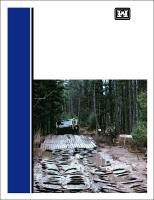Please use this identifier to cite or link to this item:
https://hdl.handle.net/11681/9251| Title: | Rapid Stabilization of thawing soils for enhanced vehicle mobility : a field demonstration project |
| Authors: | Kestler, Maureen A. (Maureen Anne) Shoop, Sally A. (Sally Annette) Henry, Karen S. Stark, Jeffrey A. Affleck, Rosa T. |
| Keywords: | Expedient roads Soil stabilization Thawing soils Cold weather conditions |
| Publisher: | Cold Regions Research and Engineering Laboratory (U.S.) Engineer Research and Development Center (U.S.) |
| Series/Report no.: | CRREL report ; 99-3. |
| Description: | CRREL Report Abstract: Thawing soil presents a formidable challenge for vehicle operations cross-country and on unsurfaced roads. To mitigate the problem, a variety of stabilization techniques were evaluated for their suitability for rapid employment to enhance military vehicle operations. A combination of mechanical stabilization methods including several lightweight fills, geosynthetics, and tire and wood mats, were constructed and tested during the annual training exercises of the 229th Engineers of the Wisconsin National Guard during the difficult conditions of spring thaw. The techniques were evaluated for their expediency, ease of construction, trafficability, and durability. In general, chunkwood was an excellent replacement for gravel fill in forested area; tree slash (or other vegetation) was effective but labor intensive; wood mats and pallets were effective and reasonably durable; tire mats were extremely rugged and effective. A loader or crane was needed to place the large wood mats, tire mats, and fascines. Geocomposite materials (Geonet) were quickly installed and could withstand limited traffic (50 passes) without additional cover material. Geosynthetics reduced the amount of cover material and enhanced placement, effectiveness and removal when used under other materials to spread the load and keep them from sinking into the mud. All materials were damaged during the severe motion of a tank cornering except the large, smooth wood mats, but these were slippery on slopes. Results are summarized in a decision matrix for choosing the best technique depending on site conditions, material and equipment availability, and utilization criteria. |
| Rights: | Approved for public release; distribution is unlimited. |
| URI: | http://hdl.handle.net/11681/9251 |
| Appears in Collections: | CRREL Report |
Files in This Item:
| File | Description | Size | Format | |
|---|---|---|---|---|
| CR-99-3.pdf | 2.62 MB | Adobe PDF |  View/Open |